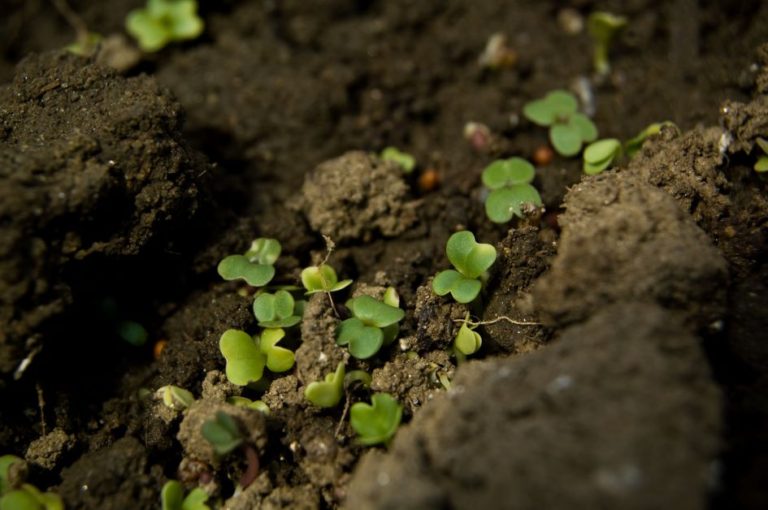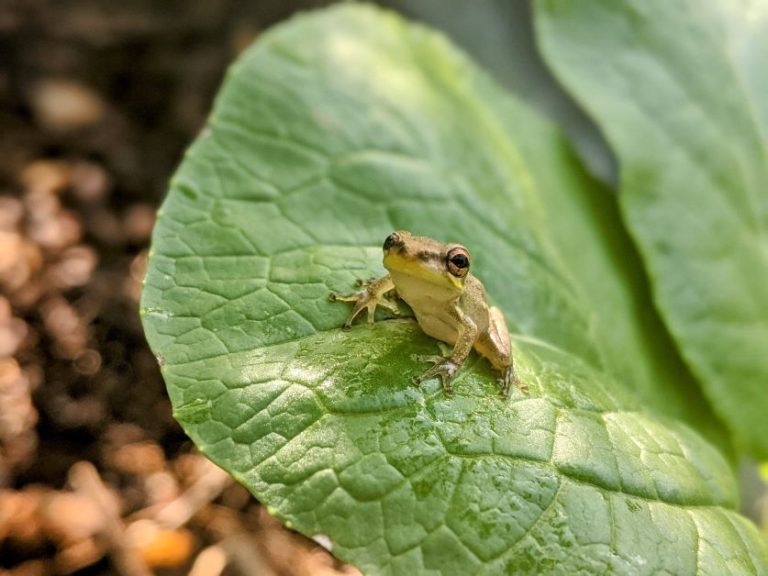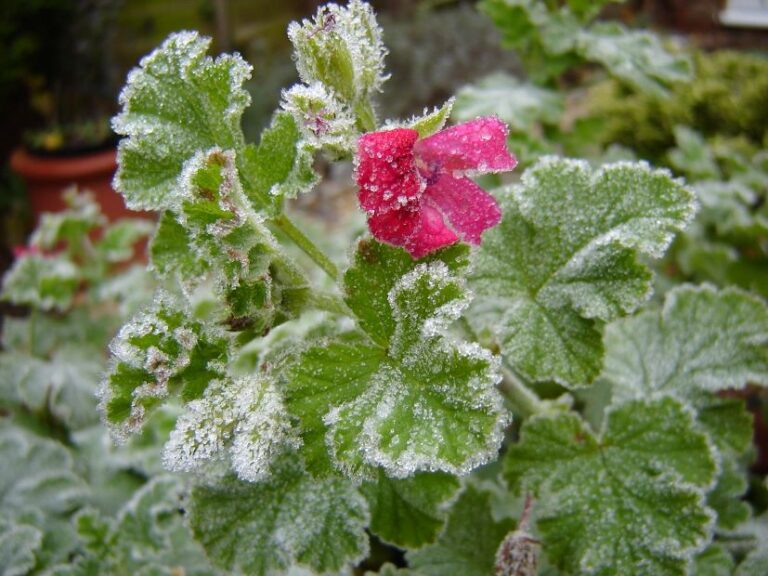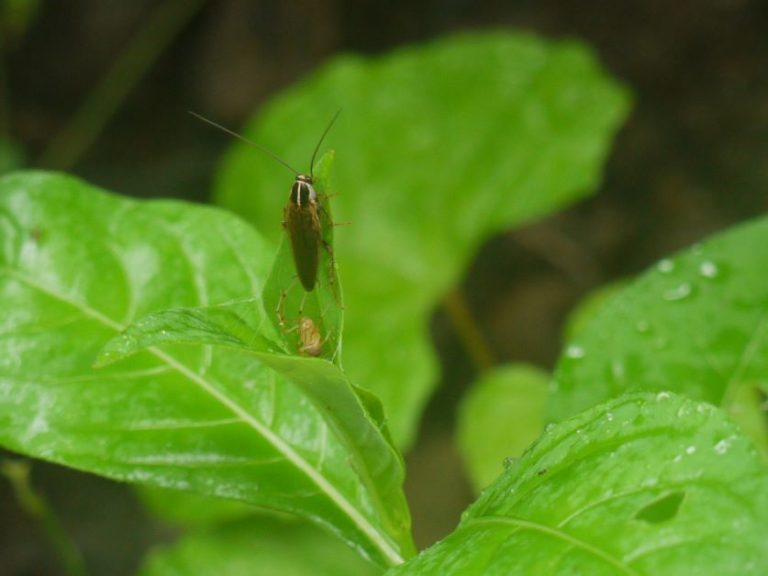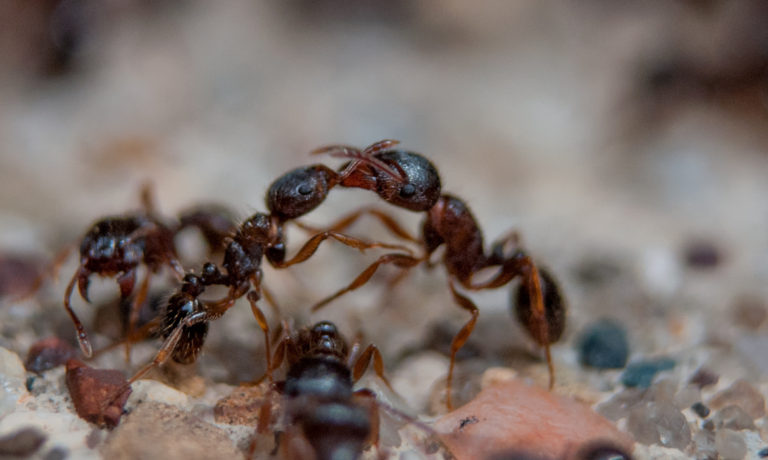The Ultimate Guide to Homemade Aphid Control
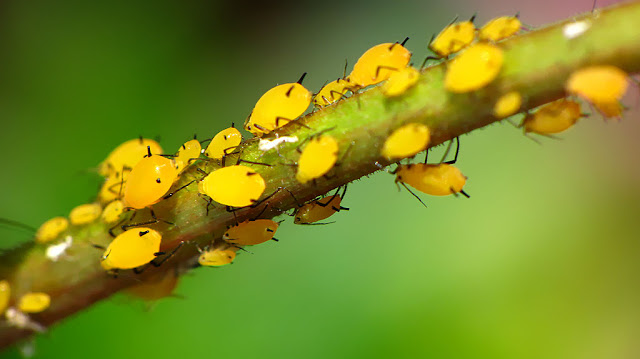
Aphids are the most interesting, most infuriating jerks in the vegetable garden. This pest can do some major damage if left unchecked. Controlling aphids is possible with some serious dedication and persistence.
What are Aphids?
Aphids are soft-bodied insects that literally suck the life out of your plants. They use their mouthparts to pierce the underside of leaves to feed on the plant’s nutrients. The aphid then excretes a sugary by-product called honeydew, which attracts ants. It’s a vicious cycle.
There are more than 5,000 different species of aphids, and they live worldwide. Some aphid species are specialized and will only eat one type of plant, while other species aren’t picky and will eat any plant they can.
The most common aphid I see in my Florida garden is the green peach aphid. This species likes to eat tons of different crops including beets, lettuces, okra, potatoes, radish, squash, tomatoes…the list goes on and on.
 |
| Credit: Marufish |
Aphids are pear-shaped and come in a range of colors, such as green, black, orange, and brown. They can have wings, depending on what life stage they’re in.
Aphid Life Cycle
The aphid’s life cycle is fascinating and complicated. Most of the time, aphids give live birth. But, if the weather is cold or if food is scarce, they’ll switch to laying eggs.
When an aphid is in live birth mode, it reproduces asexually. This means that it doesn’t need to mate with another aphid to reproduce. Instead, it clones itself and pops out up to 12 offspring a day.
A young aphid is called a nymph, and nymphs are already pregnant when they are born. It takes about a week for a newborn aphid to give birth to more clones.
Cloning…offspring that are born pregnant…it’s easy to imagine how easily aphids can get out of control. It only takes one aphid in your garden for an infestation to boom.
An aphid sheds its skin four times during its life cycle. Once an aphid population senses that the plant they’re feeding on is about to die, they grow wings and fly to another plant and start the cycle all over again.
How Do Aphids Hurt Your Vegetable Garden?
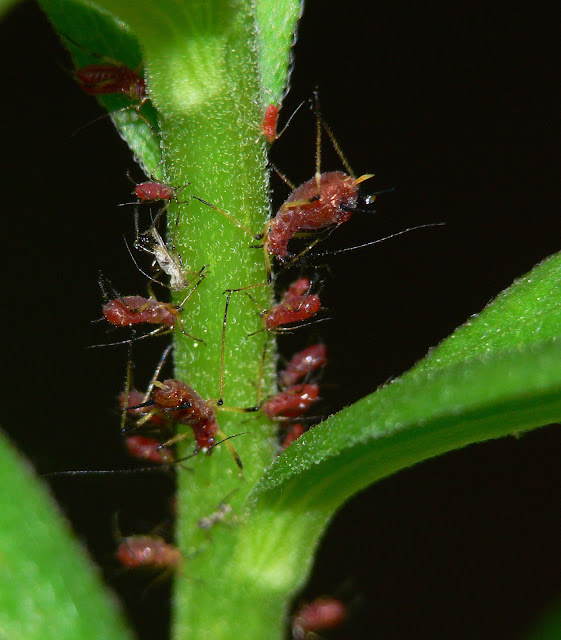 |
| Credit: Brad Smith |
Aphids can cause damage to your vegetable garden in four ways:
- Feeding on your plants
- Spreading viruses
- Causing sooty mold
- Attracting ants
Aphid Plant Damage
If your plants are turning yellow and the leaves are curling, chances are you might have aphids. Check the underside of the leaves. This is where the aphids hide and feed.
Another sign of an aphid infestation is the presence of honeydew. Honeydew looks like little droplets of water on the leaves and stems of your plant. It’s clear and sticky. This is what the aphid poops out after feeding on your plants.
Aphids tend to go for smaller, younger plants but will also attack mature plants if the aphid population is big enough.
Spreading Viruses
Aphids are one of the biggest virus vectors in the plant world.
They spread viruses from one plant to another when they’re feeding. Think of it like using dirty needles – an aphid uses its mouthparts to pierce a leaf in order to feed. If the plant has a virus, the aphid will contract it while it eats. The aphid then moves to another plant, pierces it, feeds on it, and also gives it the virus.
Once a plant contracts a virus, there is no cure.
Sooty Mold
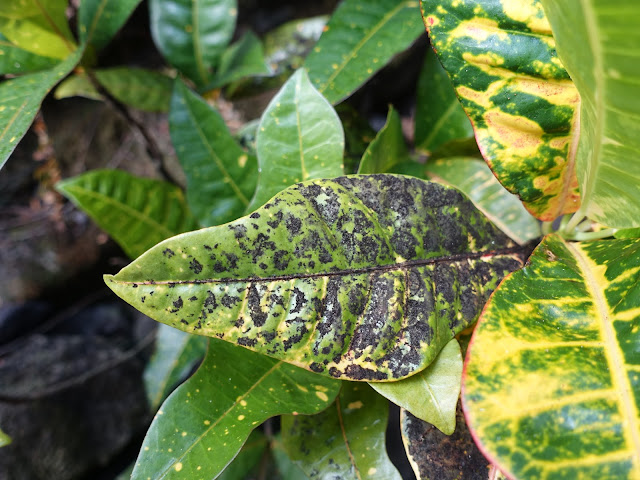 |
| Credit: Scot Nelson |
Sooty mold is a type of plant fungus that grows when there is a lot of aphid honeydew present. It looks like it sounds – like black ash or soot from a fire has fallen on your leaves, stems, or branches.
Sooty mold will usually not kill your plant, but it’s an obvious sign that you have an out-of-control aphid problem that needs to be taken care of ASAP.
Aphid and Ant Relationship
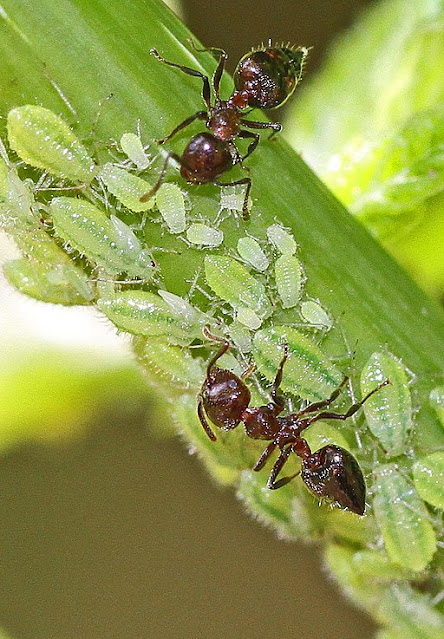 |
| Credit: Judy Gallagher |
Ants love to eat the honeydew that aphids excrete. Ants farm and gather aphids. Until the aphid grows wings, it’s a slow-moving insect. The ant will pick an aphid off the ground and carry it up to the leaves of the plant, fast-tracking the aphid to its food source. The ant will then hang around the garden to lap up the sweet honeydew.
It’s a win/win situation for everyone but the gardener – the aphid gets a free ride to its food, and the ant gets a meal out of it., too.
Aphid Control
Get Rid of Ants
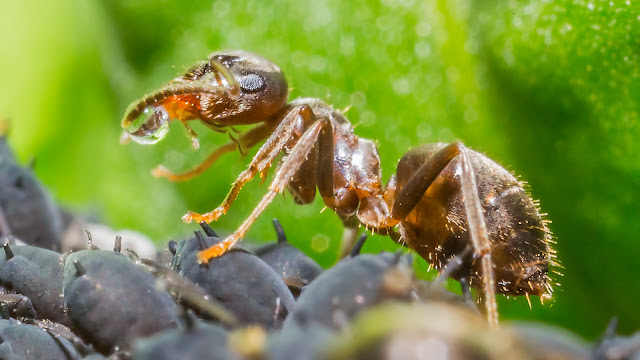 |
| Credit: Scyrene |
I go into extensive detail on how to handle an ant infestation in my article “How to Get Rid of Ants in the Garden.” It’s a must-read if you’re battling aphids.
Manual Aphid Removal
A simple way to get rid of a small aphid infestation is to remove the aphids by hand.
Aphids are really soft and easy to smash. You’ll usually find aphids in clumps underneath the leaves of your plants. When you see a clump, gently rub the leaf between your fingers. This will kill the aphids.
Pro-Tip: wear gardening gloves when smashing aphids – the guts can get a little bit gross.
Water Blasting the Aphids
Another way to get rid of aphids is to blast them with a hose. This is a good choice if your infestation is too big for you to manually remove them by hand. Rubbing leaves one by one is unreasonable if you have aphids attacking a lot of plants at once.
To kill the aphids with water, turn your nozzle to a medium-strong spray and give your plants a short blast. Aphids are so soft that the spray will smash them.
Do make sure that your nozzle isn’t set so high that the blast of water damages your plant. You may want to stick with removing the aphids by hand on very young or delicate plants.
Homemade Aphid Spray
Sprays and insecticides aren’t the best way to handle an aphid infestation in your garden. Aphids hang out in hard-to-reach areas (under leaves), and some studies have shown that some species of aphids are tolerant of insecticides.
If you’d like to make a homemade aphid spray to use in tandem with the other aphid removal techniques in this article, then try this recipe:
- 1-2 tablespoons of cold-pressed, organic neem oil
- 1 teaspoon of mild, organic dish soap
- 1 gallon of water
Mix these three ingredients in a hand-held spray pump and make sure to aim for under the leaves of your plants.
Some plants are extra-sensitive to neem oil, so do a patch test 24 hours ahead of time. Spray a little bit of the solution on a small area of your garden and check your plants the next day. If your plants have spots or look like they’re struggling, then skip the neem oil spray or add less oil to your solution.
Avoid spraying when it’s very hot or cold, or in direct sunlight. You’ll want to check the weather before spraying – don’t waste your time and money by using neem oil before it rains.
Neem oil is generally safe, but it’s toxic if swallowed so keep it away from kids and pets. Try not to get any on your hands and wash them right away if you do.
Aphid Natural Predators
Introducing the aphid’s natural predators into your vegetable garden is an effective, organic way to help curb an infestation.
You can even buy some of these natural predators online. If you do, make sure to follow the directions on the package.
Releasing natural predators into your garden as a preventative doesn’t really work – if you introduce the predator and they don’t have a food source, then the predator will fly away. To save yourself some money and disappointment, only release natural predators during an active aphid infestation, not before.
Ladybugs
Studies have shown that a ladybug can eat up to 5,000 aphids in its lifetime. You can buy ladybugs online or you can strategically plant flowers that attract ladybugs.
Ladybugs are attracted to:
- Dill
- Coriander
- Alyssum
- Bugleweed
- Coreopsis
- Cilantro
- Thyme
- Oregano
- Yarrow
Parasitic Wasps
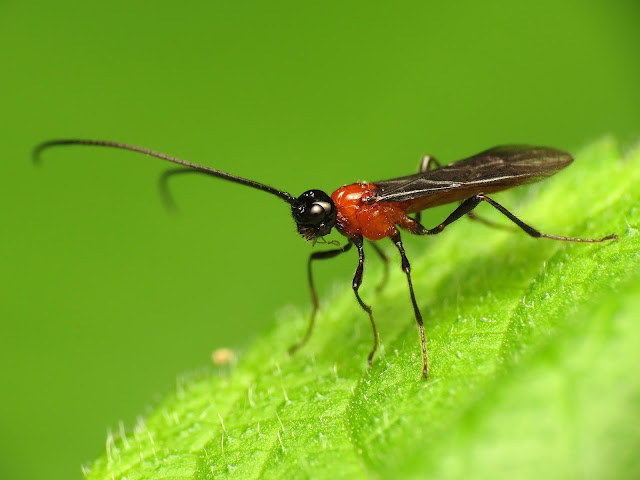 |
| Credit: Katja Schulz |
Parasitic wasps lay their eggs inside an aphid. The egg hatches while inside the aphid, and eats the aphid from the inside out. This process slowly mummifies the aphid and when the wasp is done, it bursts out of the aphid, Alien-style.
Finding little mummified aphids around the garden is a sign that you’ve got parasitic wasps doing the good work of keeping your aphid population down.
Parasitic wasps are attracted to:
- Yarrow
- Queen Anne’s lace
- Zinnias
- Fennel
- Dill
- Alyssum
- Cosmos
- Allium
- Statice
- Thyme
Green Lacewings
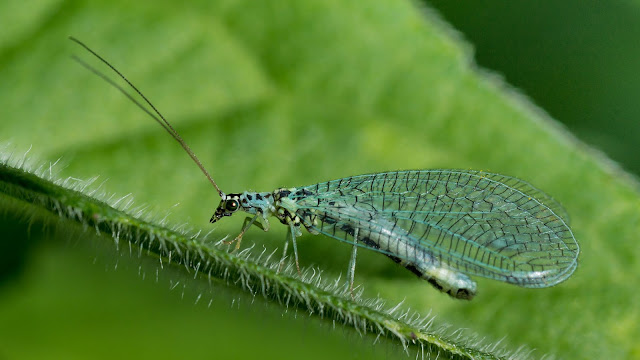 |
| Credit: MathiasKrumbholz |
Green lacewings are one of the most effective beneficial insects in the garden. They target a ton of different pests, including aphids, thrips, whiteflies, mealybugs, mites, and caterpillars.
I recommend snagging some green lacewing larvae online and adding them to your plot.
They are especially great since they eat such a wide range of pests. Along with aphids, green lacewings eat .
Green lacewings are attracted to:
- Coreopsis
- Cosmos
- Yarrow
- Goldenrod
- Queen Anne’s lace
- Marguerite daisies
Aphid Companion Planting
Companion planting is an all-natural way to control pests. Some plants will repel aphids while others draw them in and keep them occupied (and off the plants you actually care about).
Plants that repel aphids include:
- Catnip
- Marigolds
- Fennel
- Cilantro
- Garlic
- Onions
- Chives
- Leeks
Add a few of these throughout your garden to help keep aphids away. Some of the plants on this list also attract aphid predators, so choose the plants that’ll pull double duty.
As an aphid trap, I sacrifice a couple curly kale every fall and winter. Aphids really seem to love curly kale, probably because the curly leaves give them shelter. I’ll grow a curly kale or two knowing that the aphids will attack them. This keeps the aphids distracted and off of my other vegetable plants.
First photo credit: Rego Korosi
Disclaimer : I get commissions for purchases made through links in this post.


